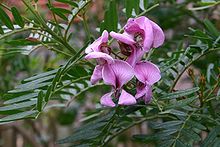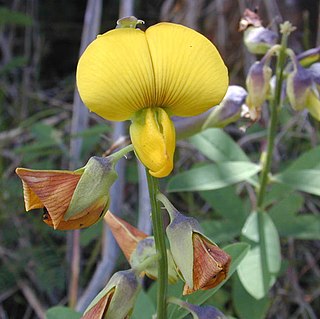
The Faboideae are a subfamily of the flowering plant family Fabaceae or Leguminosae. An acceptable alternative name for the subfamily is Papilionoideae, or Papilionaceae when this group of plants is treated as a family.

Crotalarieae is a tribe of flowering plants belonging to the family Fabaceae. It includes rooibos (Aspalathus linearis), harvested for sale as a tisane.

The tribe Amorpheae is an early-branching clade within the flowering plant subfamily Faboideae or Papilionaceae. It is found from Mexico to Argentina. It was recently found to belong in a larger clade known informally as the dalbergioids sensu lato. This tribe is consistently resolved as monophyletic in molecular phylogenetic analyses. It is estimated to have arisen 36.9 ± 3.0 million years ago. A node-based definition for Amorpheae is: "the MRCA of Psorothamnus arborescens and Eysenhardtia orthocarpa." The tribe exhibits the following morphological synapomorphies: "epidermal glands throughout the plant body; dry, indehiscent fruits that are single-seeded; and terminal inflorescences."

The tribe Brongniartieae is one of the subdivisions of the plant family Fabaceae, primarily found in tropical regions of the Americas and in Australia The members of this tribe consistently form a monophyletic clade in molecular phylogenetic analyses. The tribe does not currently have a node-based definition, but morphological synapomorphies have been identified:
"stamens united by filaments in an adaxially open tube; anthers alternately long and basifixed, short and versatile; anther connective inconspicuous; septa present between seeds in pods; aril lateral lobe present and fitting into heel of funicle; fine red glandular processes present in axils; and pollen tricolporate with opercula and no definite endoaperture."

The tribe Dalbergieae is an early-branching clade within the flowering plant subfamily Faboideae. Within that subfamily, it belongs to an unranked clade called the dalbergioids. It was recently revised to include many genera formerly placed in tribes Adesmieae and Aeschynomeneae and to be included in a monophyletic group informally known as the dalbergioids sensu lato. The members of this tribe have a distinctive root nodule morphology, often referred to as an "aeschynomenoid" or "dalbergioid" nodule.

The tribe Dipterygeae is one of the subdivisions of the plant family Fabaceae. It was recently recircumscribed to include the following genera:

The tribe Indigofereae is a subdivision of the plant family Fabaceae. It is consistently recovered as a monophyletic clade in molecular phylogenies. The Indigofereae arose 30.0 ± 3.3 million years ago.
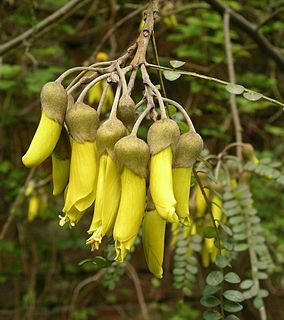
The tribe Sophoreae is one of the subdivisions of the plant family Fabaceae. Traditionally this tribe has been used as a wastebasket taxon to accommodate genera of Faboideae which exhibit actinomorphic, rather than zygomorphic floral symmetry and/or incompletely differentiated petals and free stamens. Various morphological and molecular analyses indicated that Sophoreae as traditionally circumscribed was polyphyletic. This led to a re-circumscription of Sophoreae, which resulted in the transfer of many genera to other tribes. This also necessitated the inclusion of two former tribes, Euchresteae and Thermopsideae, in the new definition of Sophoreae. Tribe Sophoreae, as currently circumscribed, consistently forms a monophyletic clade in molecular phylogenetic analyses. The Sophoreae arose 40.8 ± 2.4 million years ago.
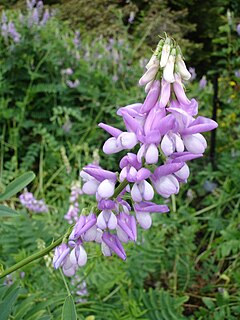
The inverted repeat-lacking clade(IRLC) is a monophyletic clade of the flowering plant subfamily Faboideae. Faboideae includes the majority of agriculturally-cultivated legumes. It is characterized by the loss of one of the two 25-kb inverted repeats in the plastid genome that are found in most land plants. It is consistently resolved in molecular phylogenies. The clade is predicted to have diverged from the other legume lineages 39.0±2.4 million years ago. It includes several large, temperate genera such as AstragalusL., HedysarumL., MedicagoL., OxytropisDC., SwainsonaSalisb., and TrifoliumL..

The tribe Amburaneae is one of the subdivisions of the plant family Fabaceae. It has been circumscribed to include the following genera, which used to be placed in tribes Sophoreae and Swartzieae:
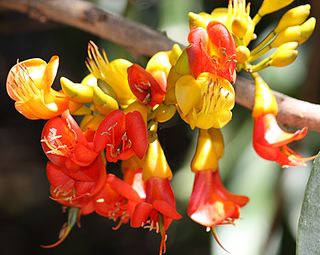
The tribe Angylocalyceae is one of the subdivisions of the plant family Fabaceae. It has been circumscribed to include the following genera, which had been placed in tribe Sophoreae:

The Cladrastis clade is a monophyletic clade of the flowering plant subfamily Faboideae that is found in eastern Asia and southern North America. It is consistently resolved in molecular phylogenies and is sister to the Meso-Papilionoideae. Evidence for the existence of this clade was first proposed based on morphological (floral), cytological, and biochemical evidence. It is predicted to have diverged from the other legume lineages 47.4±2.6 million years ago.
The Andira clade is a predominantly Neotropical, monophyletic clade of the flowering plant subfamily Faboideae. The members of this clade were formerly included in tribe Dalbergieae, but this placement was questioned due to differences in wood anatomy and fruit, seed, seedling, floral, and vegetative characters. Recent molecular phylogenetic evidence has shown that they belong to a unique evolutionary lineage. It is predicted to have diverged from the other legume lineages in the late Eocene).
The tribe Ormosieae is one of the subdivisions of the plant family Fabaceae, primarily found in tropical regions of the Americas, but also in southeast Asia and northern Australia. The members of this tribe were formerly included in tribe Sophoreae, but were recently circumscribed into a new tribe. The members of this tribe consistently form a monophyletic clade in molecular phylogenetic analyses. The tribe does not currently have a node-based definition, but morphological synapomorphies have been tentatively identified: "mostly dehiscent pods with woody valves" and "tufts of minute colleter-like glands in the axils of bract and bracteoles". Like other genistoids, members of tribe Ormosieae are known to produce quinolizidine alkaloids.

The Genistoids are one of the major radiations in the plant family Fabaceae. Members of this phylogenetic clade are primarily found in the Southern hemisphere. Some genera are pollinated by birds. The genistoid clade is consistently resolved as monophyletic in molecular phylogenetic analyses. It is estimated to have arisen 56.4 ± 0.2 million years ago. A node-based definition for the genistoids is: "the MRCA of Poecilanthe parviflora and Lupinus argenteus." One morphological synapomorphy has been tentatively identified: production of quinolizidine alkaloids. Some genera also accumulate pyrrolizidine. A new genus, to be segregated from Clathrotropis, has also been proposed to occupy an undetermined position within the genistoid clade.

The dalbergioids are an early-branching monophyletic clade of the flowering plant subfamily Faboideae or Papilionaceae. They are pantropical, particularly being found in the neotropics and sub-Saharan Africa. This clade is consistently resolved as monophyletic in molecular phylogenetic analyses. It is estimated to have arisen 55.3 ± 0.5 million years ago. A node-based definition for the dalbergioids is: "The least inclusive crown clade that contains Amorpha fruticosaL. 1753 and Dalbergia sissooRoxb. ex DC. 1825." Indehiscent pods may be a morphological synapomorphy for the clade.

Genisteae is a tribe of trees, shrubs and herbaceous plants in the subfamily Faboideae of the family Fabaceae. It includes a number of well-known plants including broom, lupine (lupin), gorse and laburnum.

The tribe Baphieae is one of the subdivisions of the plant family Fabaceae. The Baphieae tribe arose 55.3 ± 0.4 million years ago.
Meso-Papilionoideae is a monophyletic clade of the flowering plant subfamily Faboideae that includes the majority of papilionoid legumes. This clade is consistently resolved in molecular phylogenies. It contains many agronomically important genera, including Arachis (peanut), Cicer (chickpea), Glycine (soybean), Medicago (alfalfa), Phaseolus, Trifolium (clover), Vicia (vetch), and Vigna.

The Mirbelioids are an informal subdivision of the plant family Fabaceae that includes the former tribes Bossiaeeae and Mirbelieae. They are consistently recovered as a monophyletic clade in molecular phylogenies. The Mirbelioids arose 48.4 ± 1.3 million years ago. Members of this clade are mostly ericoid (sclerophyllous) shrubs with yellow and red flowers found in Australia, Tasmania, and Papua-New Guinea. The name of this clade is informal and is not assumed to have any particular taxonomic rank like the names authorized by the ICBN or the ICPN. Members of this clade exhibit unusual embryology compared to other legumes, either enlarged antipodal cells in the embryo sac or the production of multiple embryo sacs. There has been a shift from bee pollination to bird pollination several times in this clade. Mirbelioids produce quinolizidine alkaloids, but unlike most papilionoids, they do not produce isoflavones. Many of the Mirbelioids have pseudoraceme inflorescences.
